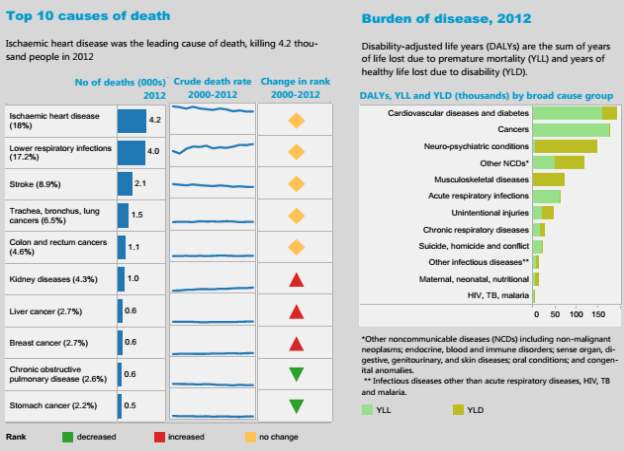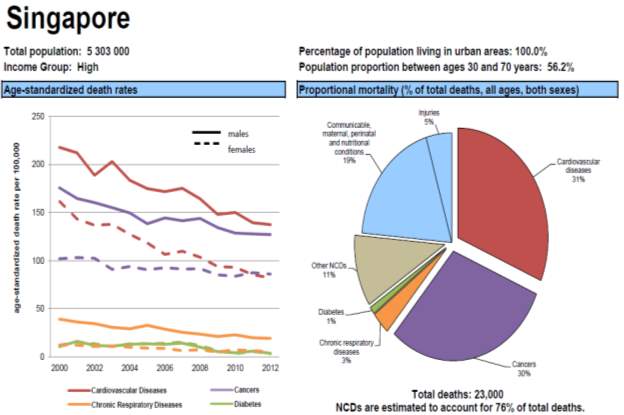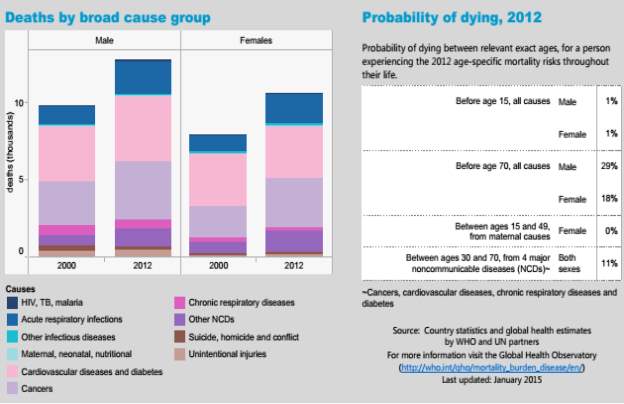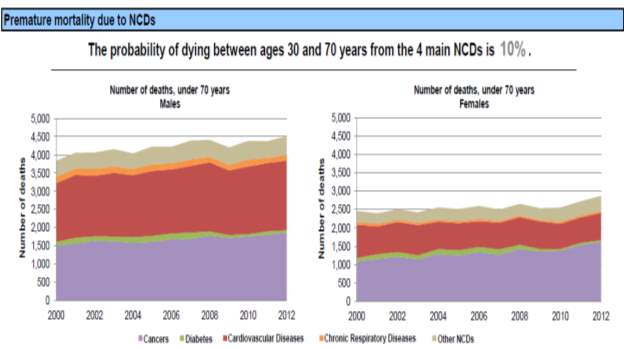“A good health system delivers quality services to all people, when and where they need them. The exact configuration of services varies from country to country, but in all cases, requires a robust financing mechanism; a well-trained and adequately paid workforce; reliable information on which to base decisions and policies; well-maintained facilities and logistics to deliver quality medicines and technologies.” (1)
EXECUTIVE SUMMARY –
The following report discusses the major health issues in urban Singapore and the process to tackle them. The major health difficulties faced by the urban population of Singapore are non-communicable diseases and ageing, which are associated to a change in lifestyle due to 100% urbanisation. Ageing is linked with non-communicable diseases. This report describes UN-habitat as a healthy setting approach which can help in healthy ageing thereby reducing the occurrences of non-communicable disease. Recommendations based on the principles of UN-habitat are provided to tackle these health issues faced in Singapore.
INTRODUCTION –
Singapore is a comparatively small country consisting of small islands in the most south east part of the Asian continent. Singapore is one of the most urban nations on the planet. Having 100% urbanisation, all the population lives in an urbanised area with no possible rural life. (2) The total population is around 5.7 million with an average life expectancy around 83 years of age, higher than compared to any other nations in the south east. (2) The average male to female life expectancy is 80 to 86 years of age respectively. In the year 2013-14, Singapore had a second rank in the world health ratings for an efficient and durable health care system making it a healthy nation. Due to this there was an increase in the cost of health care by 13%. (2) The main health issue which is currently damaging the health system of Singapore is rising the number of non-communicable diseases as well as the population which is affected. When a healthy health care system faces a major health issue it is a challenge for the health system to tackle it in the future. (2) The burden of non- communicable diseases will have a huge impact on the 100% urban health system of Singapore. (2) The purpose of the following report is to understand the key health issue and its impact on the urban community with the help of data collected by the health system about the issue and measures taken to tackle the burden of non-communicable diseases. The data collected by the health system will be beneficial to understand the necessity of tackling this issue for the present and in the future. Based on the limitations and advantages of the measures by the health system, recommendations will be provided to improvise the measures which have been already taken towards the issue.
HEALTH ISSUES –
Non-communicable Diseases –
The urban community of Singapore faces a burden of non-communicable diseases (NCDs) faced by many other developed countries in the world. (3) Rapid increase of the effects and impacts of NCDs on the health and the health system are seen in the urban community of Singapore. (3) More than 5 of the major NCDs are observed affecting the urban population, they are –
- Ischaemic heart disease, (3)
- Lower respiratory disorders, (3)
- Stroke, (3)
- Cancer – which is related to all important organs, (3)
- Chronic obstructive pulmonary disorder (3) and
- Kidney diseases. (3)
Picture number one shown below explains the top 10 causes of death (all NCDs) on the left side showing an increase in deaths caused by kidney diseases, liver cancer and breast cancer; with a slight decrease in the deaths caused by stomach cancer and chronic obstructive pulmonary disorder. (4) The table shows there is no change in the number of deaths between 2000 to 2012 in deaths caused due to ischaemic heart disease, stroke, lower respiratory disorder, lung and related organ cancers along with colon and rectal cancer. (4) The graphs on the right side explains the disability-adjusted life years which are caused by the above mentioned NCDs. (4)
- Picture 1 – (4)

There is a rise seen in the mortality rates and the morbidity from the major NCDs in Singapore and it has a possibility of increasing in the future. In the picture number two shown below, there are two graphs. (4) The graph on the left side shows the death rates have decreased over the period of 12 years in males and females affected from NCDs. The pie-diagram on the right side shows the mortality in percentage taking into consideration deaths due to all kinds of diseases and injuries. (4) Only 24% of deaths in the overall population is resulting from communicable diseases and injuries. Rest 76% of total deaths are accounted for NCDs. Statistics state that there is going to be 21% rise in the next decade due to NCDs. (4)
- Picture 2 – (4)

Globalisation, poverty and unplanned urbanisation are the three major determinants for the rise of NCDs. Associated to the NCDs there are some risk factors. (3) These risk factors are extremely established in Singapore and are on the rise. The origins of NCDs in the society are due to environmental, social, economic and cultural conditions simultaneously having the risk factors as well. (3) The risk factors associated to NCDs are as follows –
- Use of tobacco, (3)
- Harmful use of alcohol, (3)
- Physical inactivity (3) and
- Unhealthy diet. (3)
Exposure and vulnerability of the population towards NCDs and health outcomes is influenced by the socio-economic determinants. Immense amount of economic consequences of NCDs are faced in Singapore. (3) Financial support has been decreased for essentials like education and food due to an increase in the demand for nonessential and unhealthy factors like tobacco and alcohol. (3) These consequences affect the health care expenditure of the families lead by an unfortunate rise in use of nonessential and unhealthy factors. (3) Picture three below explains the causes of death by different parameters. The table on the right side explain the age specific risks of mortality throughout life. (4) It shows that probability of deaths occurring in between the ages of 30 to 70 years in both males and females, is because of NCDs. The graph on the left compares the deaths occurred in both males and females. (4) It shows that there is a rise in the number of deaths caused by NCDs in both males and females over the period of 12 years from 2000 to 2012. (4)
- Picture 3 – (4)

The causes of death in the age group between 30 to 70 years are because of the effect of 10% of the 4 major NCDs. Premature mortality is experienced by the urban community of Singapore due to the NCDs. (4) Majority of the deaths are caused by cardiovascular diseases and cancers, rest are caused diabetes, chronic respiratory disorders and some of the other NCDs. Picture number four below shows the probability of dying in males and females aged between 30 to 70 years. (4) Both graphs on the picture show a rise in the mortality due to the NCDs over a period of 12 years from 2000 to 2012. There will be a further rise in the mortality rates of NCDs in the urban population of Singapore. (4)
- Picture 4 – (4)

Ageing –
Ageing is another major health issue which is on the rise in the entire world. In Singapore, due to the decrease in death rate and fertility rate, ageing population has been an incipient issue. (5) Rapid change in the population in the world is observed in Singapore as well. There are four main causes of ageing in Singapore –
- Increased life expectancy, (5)
- Decreased fertility rate, (5)
- Decreased population growth rate (5) and
- Increased access to quality of health care services. (5)
In the year 2014, the total health care expenditure of Singapore was 4047 US dollars. (4) In the past 10 years, life expectancy has been increased from 75 years of age to 82 years to the year 2015. (4) The fertility rate has been low to 1.3 which has decreased the population growth rate. Ageing population is directly proportional to the decrease in the population growth rate in Singapore. (4) This has led to the rise in the economic and social economic impacts on the urban communities. There was an increase in the burden of diseases and disability, number of individuals who are dependent on the families along with hampered quality of life and social security for the elderly. (5) Due to decrease in the workforce, higher taxes for the elderly, lower standard of living, reduced economic growth with reduction in the per capita production the urban population face the economic impacts of ageing. (5)
HEALTHY SETTING APPROACH –
Building healthy policies, creating supportive environments, strengthening community action for health, reorienting health services and developing personal skills are five priority areas where the World Health Organisation promotes health with the help of social utilisation, advocacy and education. (6) To tackle the effects of rapid urbanisation, climate change, environmental deprivation, unhealthy lifestyles and widening inequities, reinforced promotion and advocacy are required. (6) To promote and protect health, approaches are required towards the government and the society. Public health urgencies and incorporation of health promotion and protection into a national development strategy is offered in an effective way by the healthy settings approach. (6) To achieve success factors like multisector collaboration, political commitment, citizen participation and community engagement are very crucial. (6)
UN-habitat is a program which has been started by United Nations operates for a better future. (7) This program promotes development of human settlements which are socially and environmentally sustainable. To address the health issues of ageing and non-communicable diseases in Singapore, UN-habitat has some principles. (7) These principles will help tackle and find adequate techniques to improve the effect of health issues. The principles which link Singapore to the health issues are – a city which is regenerative and resilient, a city which is well-planned, walkable and transport friendly and which should be healthy, safe and the city which promotes well-being. (7) These principles will help guide the city for a healthy atmosphere for ageing and tackle the growing issue of non-communicable diseases (NCDs). (8) As Singapore is 100% urbanised the burden of health issues in the rural area and people under the poverty line has been reduced and limited. (8) Due to this economy of the city changed along with the change in lifestyle of the population. This increased health issues of malnutrition and infectious diseases to shift towards the NCDs. (8)
RECOMMENDATIONS –
The principles of UN-habitat help tackle the health issues as they link with the healthy living master plan for Singapore along with the action plan developed by the Singapore government for the future of elder population. The main topics for the healthy living master plan developed by Singapore state that health promoting facilities which motivate healthy living should be easily available and accessible, for behavioural change, family and social support is very essential and all the population should be able to afford and access the options to develop a healthier living. (9) Ageing and NCDs are associated. As per the statistics, by the year 2030, the population of people aged more than 65 years will be tripled. (9) Due to the rise in the older population, the tendency to develop NCDs is quite high. Stroke, heart diseases, chronic respiratory disorders, cancers and mental disorders account to 70% of deaths in Singapore. (9) Number of risk factors affecting the lifestyle and dietary factors which influence the rise in NCDs. Obesity, cigarette smoking, alcohol consumption and high blood cholesterol are the risk factors which are associated with the burden of diseases. A change in lifestyle will help manage the risk factors. (9) To tackle the NCDs health issues as per the UN-habitat principle, a variety of changes should be done in Singapore with the help of the government –
- Building a healthy and safe workforce which will help by improving the quality of life, prevent injuries and death from accidents and preventing and managing work and lifestyle which can affect the health and will have a risk of developing NCDs. (8)
- Health promoting facilities in the community should be incorporated. These facilities will motivate the younger and middle aged population for adequate physical activity and a balanced diet. (9) These facilities will also motivate to reduce the habits of cigarette smoking and alcohol consumption. This will benefit against the development of NCDs in the future. (8)
- Due to lack of physical activity and healthy dietary habits, peer support to encourage healthy habits is required. (9) These activities also involve the communities to promote cessation of smoking as well as consumption of alcohol. Family, friends and colleagues at workplaces or hospitals help in counselling and promotion of the cessation of the habits. (8)
- Partnership with the private companies so that these companies will benefit he communities with healthier eating options. (8) To battle the obesity problem, delivery of highly nutritional food is essential by the companies to the vulnerable population. (8) Rising sugar intake from sugar drinks in Singapore should be reduced and substituted by beverages containing less or no sugar and water. (9)
Healthy ageing is the right of each person above 65years of age in the population of Singapore. (5) Based on the principles of UN-habitat, Singapore should develop its action plan to secure the future of the elder population. To help tackle the ageing problem, these are some of the recommendations which the government should consider –
- Employability – every citizen has the right to work small jobs as a source of income after retirement from professional life. Workplaces need to hire people not based on their age. Aged population should have the availability of lifelong working. They should be able to work on their own will. (5)
- Lifelong learning – they should be able to learn through school for elders. (5)
- Senior volunteering – aged population should be able to volunteer for health programs in the community and help in fulfilling lives. (5)
- Health and wellness – healthy senior population means happy senior population. Recreational facilities should be built especially for the elderly to have a healthy environment. (5) (9)
- Aged care services – aged care services should be increased in number for helping elderly to remain independent and healthy. (5) (8) (9)
- Transport and housing – travel experience for the elderly should be re-defined which will benefit them from travelling to short as well as longer distances. Housing for the elderly should be supported with any changing needs. (5) (9)
- Public spaces should be constructed by making our urban infrastructure more senior friendly and safe. (5) (8) (9)
- More amount of research is needed for understanding the needs of the elderly as well as new innovations which will be beneficial for them should be encouraged. (5)
CONCLUSION –
The above given recommendations are based on the principles of UN-habitat. To tackle the ageing problems which are directly linked with the NCDs these principles are necessary. The planning of the city provides a major role towards making it healthy and safe. A well-planned city with the benefits for elderly like walkability, easy access to public transport, recreational areas for recreational activities which would also help in reducing the effects of NCDs on ageing. A regenerative and resilient city helps the population to adopt and sustain healthy lifestyles by making healthy living accessible, effortless and natural. UN-habitat has worked for Singapore to develop transport and mobility, sustainable environment and the development of parks and other recreational activities. Considering the limitations of UN-habitat which are generally aiming for long-term global change, immediate results cannot be obtained. The government should follow and apply the principles of UN-habitat to achieve a healthy and safe environment for the urban population ultimately by reducing the health issues like ageing and non-communicable diseases in the future.
REFERENCS –
- World Health Organisation. Health systems [Internet]. World Health Organisation. 2017 [cited 24 September 2017]. Available from: http://www.who.int/topics/health_systems/en/
- World Health Organisation. Singapore [Internet]. World Health Organisation. 2017 [cited 25 September 2017]. Available from: http://www.who.int/countries/sgp/en
- World Health Organisation. Non-communicable diseases in South-East Asia region [Internet]. World Health Organisation. 2011 [cited 25 September 2017]. Available from: http://www.searo.who.int/nepal/mediacentre/2011_non_communicable_diseases_in_the_south_east_asia_region.pdf
- World Health Organisation. Non-communicable diseases (NCDs) [Internet]. Who.int. 2014 [cited 27 September 2017]. Available from: http://www.who.int/nmh/countries/sgp_en.pdf?ua=1
- The Ministry of Health. I Feel Young in My Singapore [Internet]. Ministry of Health Singapore. 2016 [cited 27 September 2017]. Available from: https://www.moh.gov.sg/content/dam/moh_web/SuccessfulAgeing/action-plan.pdf
- World Health Organisation. Non-communicable diseases [Internet]. World Health Organisation. 2012 [cited 25 September 2017]. Available from: http://www.wpro.who.int/regional_director/regional_directors_report/2012/media/03_DHP_03_NHP.pdf
- UN-Habitat. The City We Need – Towards a New Urban Paradigm [Internet]. UN-Habitat. 2016 [cited 24 September 2017]. Available from: http://www.worldurbancampaign.org/sites/default/files/documents/tcwn2en.pdf
- Healthy City Support Organisation. Making Singapore a Healthy Urban City [Internet]. Healthy Cities, Healthy Partners. 2016 [cited 27 September 2017]. Available from: https://www.healthy-partners.net/2017/02/23/making-singapore-a-healthy-urban-city/
- Ministry of Health Singapore. Healthy Living Master Plan [Internet]. Ministry of Health and Health Promotion Board. 2014 [cited 25 September 2017]. Available from: https://www.moh.gov.sg/content/dam/moh_web/Publications/Reports/2014/HLMP/MOH_Healthy%20Living%20Master%20Plan_Inside%20Page_8d.pdf
Cite This Work
To export a reference to this article please select a referencing style below:
Related Content
All TagsContent relating to: "strategies"
Strategies in nursing and healthcare help to be clear about the direction and main areas of development for nurses and nursing over the next few years to better meet the needs of service users, their families and carers.
Related Articles


